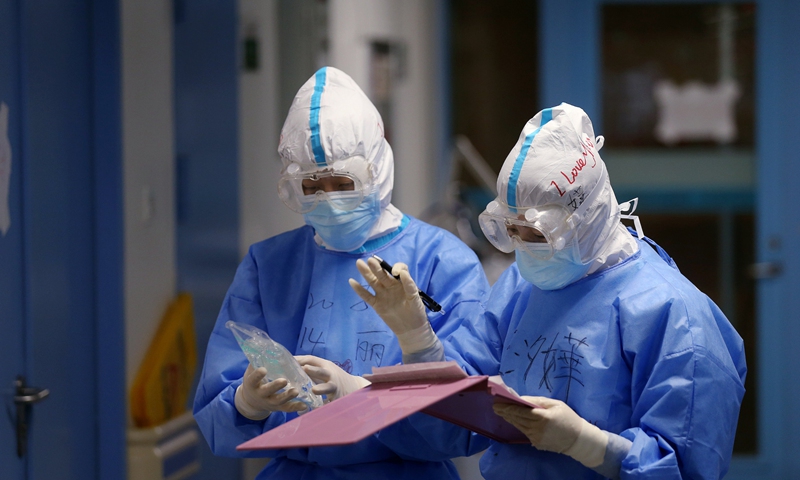Rising COVID-19 infections in Kashi spark concerns of epidemic spread
By GT staff reporters Source: Global Times Published: 2020/10/31 23:46:59
Experts warn about early stages of community spread, urging thorough epidemiological investigation

Photo: Xinhua
Kashi in Northwest China's Xinjiang Uygur Autonomous Region reported 61 new silent virus carriers on Saturday alone as it finished the second round of nucleic acid testing in key villages, sparking public concern about whether the initial clustered outbreak linked to a local clothing factory has spread in the region.
According to Xinjiang officials, among the new cases, 46 are from Shufu county and the remaining 15 are from two villages in Akto county in neighboring Kizilsu Kirgiz Autonomous Prefecture. All involve people who were put into quarantine at the beginning of the Kashi epidemic, after a silent virus carrier was found on October 24.
Three confirmed cases were also discovered on Saturday, all from existing silent carriers, taking the total number of existing infections in Xinjiang to 273 - 54 confirmed and 219 asymptomatic - the local health authority said on Sunday.
Facing these rising numbers, Chinese experts reached by the Global Times said that these new infections could be a result of patients in the incubation period or false negative nucleic acid tests. They called for a more thorough epidemiological investigations to detect the real source of infection - whether it began in Kashi Prefecture's Shufu county or Akto county in Kizilsu Kirgiz Autonomous Prefecture.
Gu Yingsu, deputy head of the local health commission in Xinjiang, said at Saturday's press conference that the 15 people from Kizilsu Kirgiz Autonomous Prefecture were tested negative in the first-round nucleic acid test but tested positive in the second-round test.
When Kashi rolled out the first round of citywide free tests, Kizilsu Kirgiz Autonomous Prefecture had also conducted citywide nucleic acid tests. first round of nucleic acid testing in Kashi covering more than 4.7 million people finished on Tuesday, according to Gu.
The second round of nucleic acid testing for residents of Kashi and close contacts living in the nearby villages of Kizilsu Kirgiz Autonomous Prefecture was completed within three days on Saturday, Gu said. Apart from those reported silent carriers and confirmed cases, all other residents tested negative for COVID-19.
The rising infections in Shufu and in the neighboring villages of Kizilsu Kirgiz Autonomous Prefecture mean the outbreak has already been spreading in those places, Zhang Yuexin, a member of Xinjiang's anti-epidemic group, told the Global Times on Saturday. These people must be close contacts of previous COVID-19 infections, or close contacts of the close contacts, but patient zero is still unknown, Zhang said.
Wang Guangfa, a respiratory expert at Peking University First Hospital, also said that since the source of the infections in Shufu remains unknown, whether it began in Shufu or Akto is difficult to judge. "The place where epidemic was reported later could also be the source of origin, or one of the two branches of the same origin," Wang said, emphasizing the importance of epidemiological investigation.
Wang suggested speeding up the epidemiological investigations and screening of cold-chain products and key population groups connected to the clustered infections in Shufu, which he said would be more effective than conducting massive nucleic acid testing.
Chen Xi, an associate professor of the Yale School of Public Health, also told the Global Times that tracking close contacts at this moment is critical. Suppress the spread at the community level so to avoid wider lockdown in the future, Chen noted.
Asked why those 61 COVID-19 infections were not detected in the first round of nucleic acid tests, experts and officials believed it could be a result of incubation period.
Gu said the incubation period of the novel coronavirus infected patients is one to 14 days, and the common incubation period is three to seven days, meaning that about 90 percent of people will test positive within three to seven days after infection, some in less than three days, and some people after more than seven days.
Chinese experts believed false negative nucleic acid tests also cannot be ruled out when they were first done. Repeated tests can prevent false negative test results.
Wang warned that asymptomatic patients are also contagious and if asymptomatic patients continue to be reported, it could mean a forgotten zone for anti-epidemic work. A thorough epidemiological investigation will plug the gap.
The COVID-19 infections will see a gradual decrease in seven days and a noticeable decline in about 14 days, if anti-epidemic measures are accurate and effective, Wang said, adding that it will take several more days to tell whether the Xinjiang epidemic is being tamed.
Newspaper headline: Rising infections in Kashi spark concerns of epidemic spread
Posted in: SOCIETY